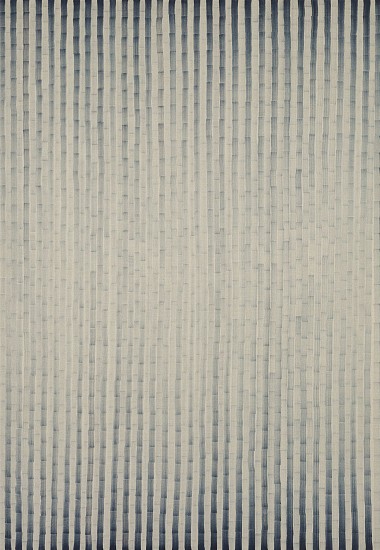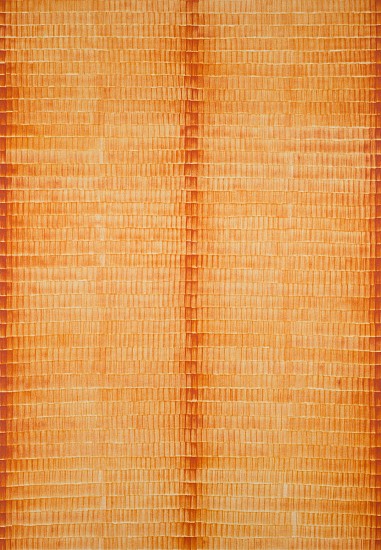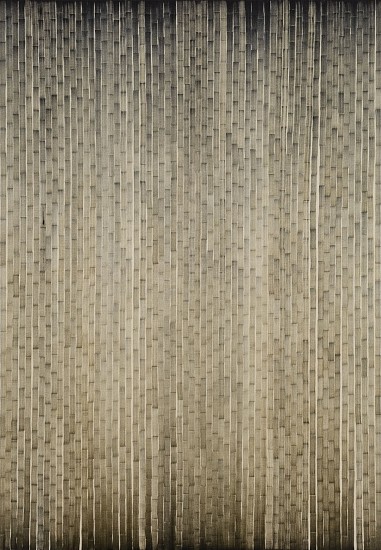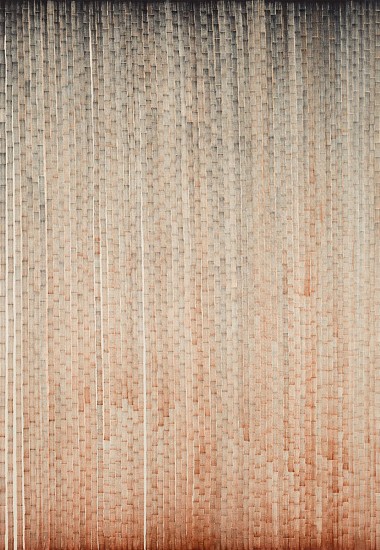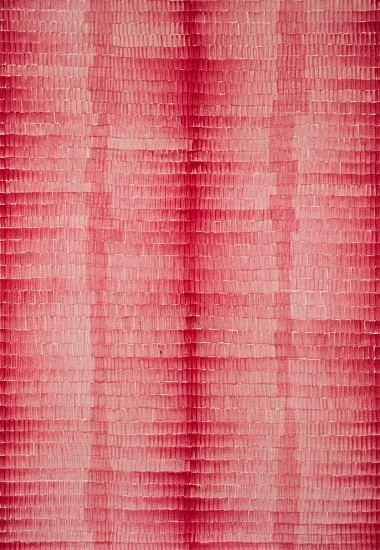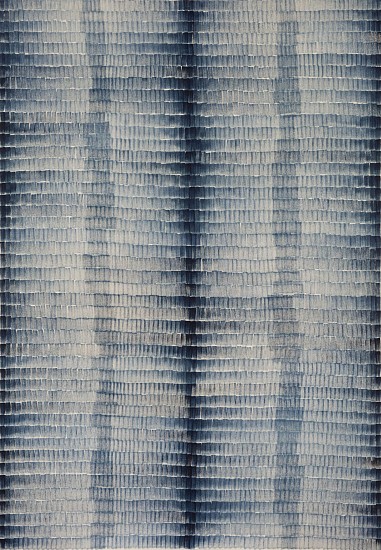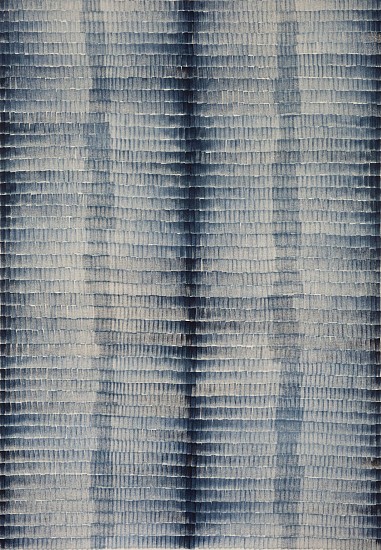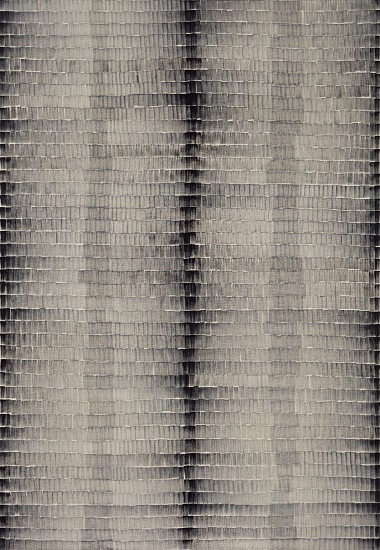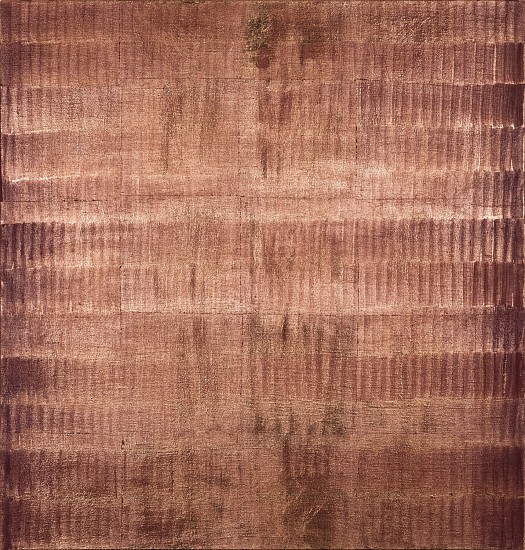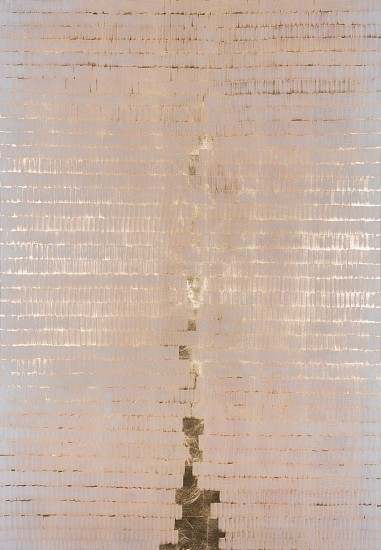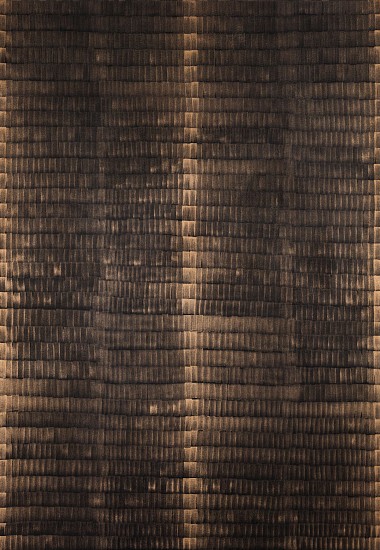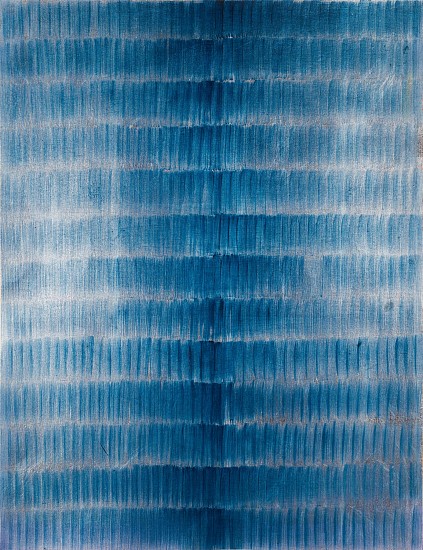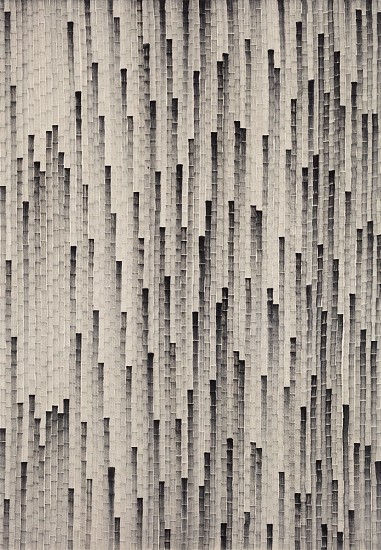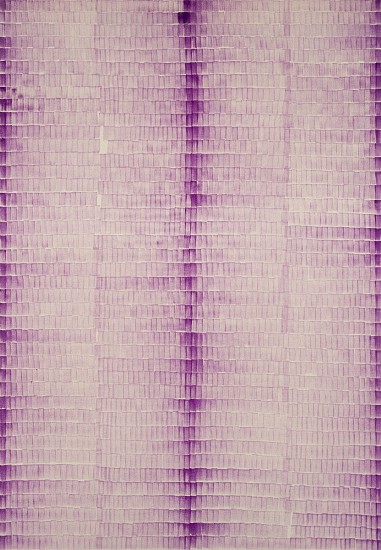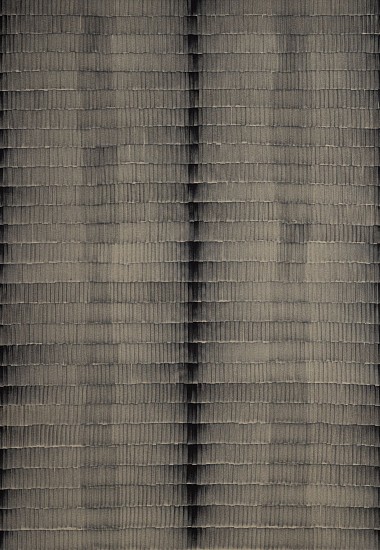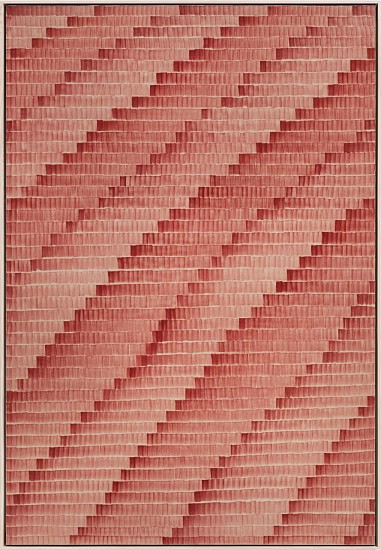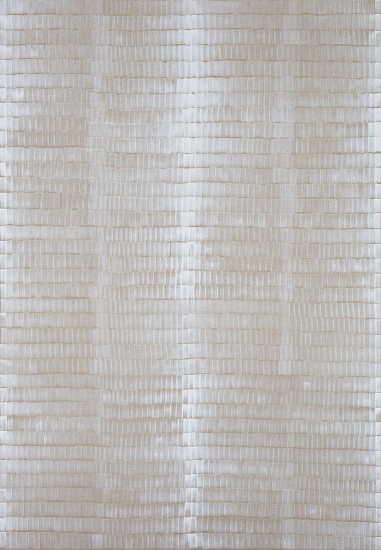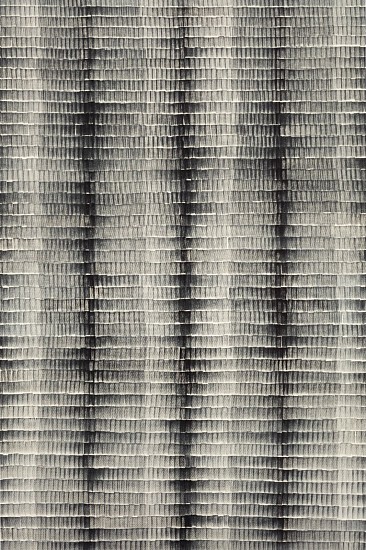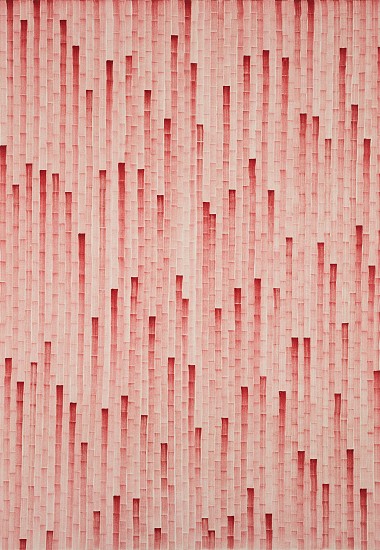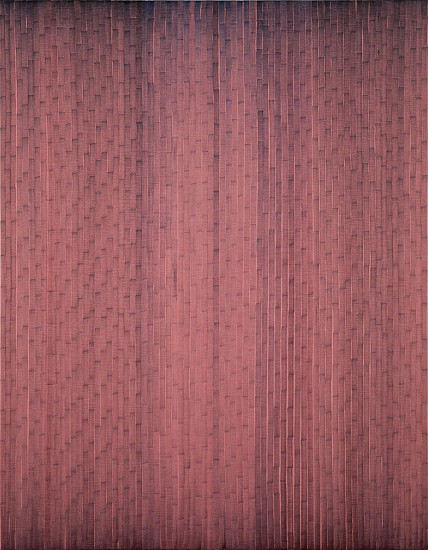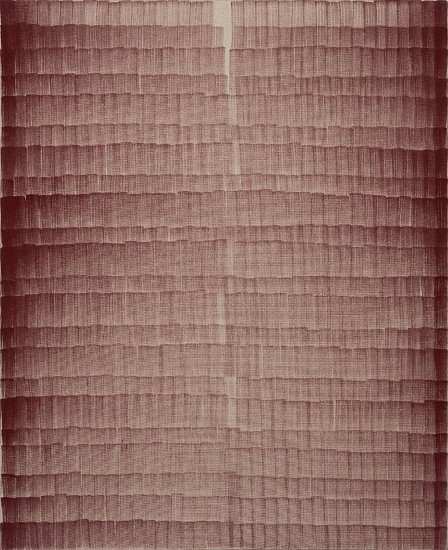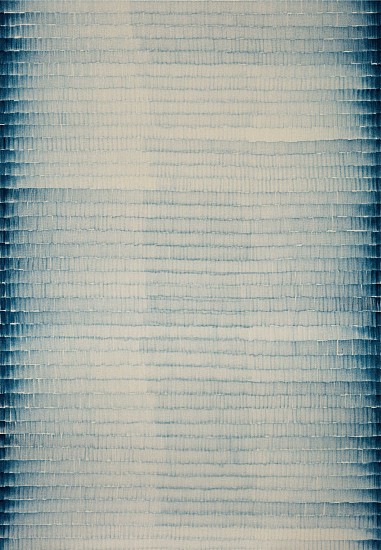CATHY ABRAHAM



CATHY ABRAHAM, Alternate loves Indigo
oil on Italian cotton canvas, 144 x 100 cm
Cathy Abraham’s practice is deeply influenced by artists from the Korean Dansaekhwa movement, along with the repetitive incantations of artists such as Roman Opalka and Agnes Martin, among others.
Abraham works systematically with repetitive gestures as a way of thinking through the patterns and experiences that mark our daily existence. The highly developed surfaces of her work consider boundaries between reality, fantasy and illusion.
‘I count brush marks as a form of meditation, allowing the mark of the brush to leave a visual trace as ghosts do. The “ghostings” are composed from an overlapping series of brushmarks. At first laden with paint the brush begins to make its mark yet through the sequence of strokes, its colour diminishes until there is only an unstable, fragmented residue. I cannot be sure what residues haunt and inspire me, as there are so many events I would like to forget, yet I remain aware of these experiences and their after-effects. By repeatedly drawing or painting the seemingly same mark, I am hoping to find expression for the inexpressible, bringing into existence that which is intangible yet felt.’




CATHY ABRAHAM, An orange splendour (6048 strokes)
oil on Italian cotton canvas, 144 x 100 cm
Cathy Abraham’s practice is deeply influenced by artists from the Korean Dansaekhwa movement, along with the repetitive incantations of artists such as Roman Opalka and Agnes Martin, among others. Abraham works systematically with repetitive gestures as a way of thinking through the patterns and experiences that mark our daily existence. The highly developed surfaces of her work consider boundaries between reality, fantasy and illusion. ‘I count brush marks as a form of meditation, allowing the mark of the brush to leave a visual trace as ghosts do. The ‘ghostings’ are composed from an overlapping series of brushmarks. At first laden with paint the brush begins to make its mark yet through the sequence of strokes, its colour diminishes until there is only an unstable, fragmented residue. I cannot be sure what residues haunt and inspire me, as there are so many events I would like to forget, yet I remain aware of these experiences and their after-effects. By repeatedly drawing or painting the seemingly same mark, I am hoping to find expression for the inexpressible, bringing into existence that which is intangible yet felt.’



CATHY ABRAHAM, Ascending and descending earth
oil on Italian cotton canvas, 144 x 100 cm
Cathy Abraham’s practice is deeply influenced by artists from the Korean Dansaekhwa movement, along with the repetitive incantations of artists such as Roman Opalka and Agnes Martin, among others.
Abraham works systematically with repetitive gestures as a way of thinking through the patterns and experiences that mark our daily existence. The highly developed surfaces of her work consider boundaries between reality, fantasy and illusion.
‘I count brush marks as a form of meditation, allowing the mark of the brush to leave a visual trace as ghosts do. The “ghostings” are composed from an overlapping series of brushmarks. At first laden with paint the brush begins to make its mark yet through the sequence of strokes, its colour diminishes until there is only an unstable, fragmented residue. I cannot be sure what residues haunt and inspire me, as there are so many events I would like to forget, yet I remain aware of these experiences and their after-effects. By repeatedly drawing or painting the seemingly same mark, I am hoping to find expression for the inexpressible, bringing into existence that which is intangible yet felt.’
CATHY ABRAHAM, Ascending and descending Mars, 2023
oil on stretched Italian cotton canvas, 144 x 100 cm (56 5/8 x 39 1/4 in.)


CATHY ABRAHAM, Caput mortem ghost
oil on Fabriano Rosapina paper, 100 x 70 cm
Abraham calls her brushstrokes ‘ghosts’ as a metaphor. The pigment of the brush comes and goes like ghosts of memory or as actual ghosts do. Sometimes very intense when the brush is first dipped in paint, until it is very faint at the end of its allotted count, but always there is a residue. These memories, or ghosts, often occur simultaneously and overlap. The brushstrokes do this in the paintings too.
CATHY ABRAHAM, Cast in stone Crimson I (22 pathways)
oil on stretched Italian cotton canvas, 144 x 100 cm
CATHY ABRAHAM, Cast in stone Indigo depths (22 pathways)
oil on stretched Italian cotton canvas, 144 x 100 cm
CATHY ABRAHAM, Cast in stone peach black I (22
pathways)
oil on stretched Italian cotton canvas, 144 x 100 cm
pathways) | | Everard Read London


CATHY ABRAHAM, Copper blue 18,
oil and copper leaf on dyed indigo linen, 54 x 44 cm
“My creative process is grounded in the choice of number as symbol. I have chosen to work with gematria, which is an alphanumerical system within the Jewish mysticism of Kabbalah. Each letter is ascribed a numerical value and it is these numbers that I use as the underlying composition of my works. The number 18 means ‘life’ and I use this number over and over again as a way to reinfuse ‘life’ back into that which is broken, discarded or under threat of extinction. Could be memories, loss, or environmental concerns.”
- Cathy Abraham, Five Questions with Cathy Abraham by Nkgopoleng Moloi, March 2025


CATHY ABRAHAM, Copper ghost
oil and copper leaf on dyed red linen, 63 x 60 cm
The ghosting are composed from a series of brush marks. At first laden with paint the brush begins to make its marks, yet through the sequence of strokes, its colour diminishes until there is only an unstable, fragmented residue which is what she calls ‘ghosting’. While events of wounded historical experiences may remain locked in the past, their inaccessibility becomes manifested through this mediative process of painting and drawing. There are residues of ghostliness that both haunt and inspire me as there are many events I would like to forget, yet I remain aware of these experiences and their after-effects. By repeatedly drawing or painting the seemingly same mark, I am hoping to find expression for the inexpressible, bringing into existence that which is intangible yet felt.
- Cathy Abraham


CATHY ABRAHAM, Copper green 18
oil and copper leaf on Italian cotton, 54 x 44 cm
My unfolding engagement with numbers, symmetries, and ritual action is meditative and devotional, a means of transcending the self towards an understanding of the interconnected, miraculous nature of all beings. These reflections find resonance in Kabbalah’s numerical interpretation of holy texts, where every Hebrew letter is given a value, and each number, in turn, is lent a spiritual significance. 18 and its multiples, which symbolise life in mystic tradition, are central to my process, as is 8 for the transcendence of the physical and 13 for the attributes of love
- Cathy Abraham


CATHY ABRAHAM, Counting to life indigo on rust
oil and pastel on book linen, 54 x 44 cm
“In the recitation of these numbers in my practice, the living and the dead, the accepted self and its disavowed darkness, the individual and the great entanglement of the universe, find a place to coincide. Mark after mark, gesture after repeated gesture, counting the brushstrokes with their allotted number until the paint leaves only a faint trace, the making of each work affords moments of quiet revelation.”
- Cathy Abraham




CATHY ABRAHAM, Crown
Oil and gold leaf on Italian cotton canvas, 144 x 100 cm
Cathy Abraham’s practice is deeply influenced by artists from the Korean Dansaekhwa movement, along with the repetitive incantations of artists such as Roman Opalka and Agnes Martin, among others. Abraham works systematically with repetitive gestures as a way of thinking through the patterns and experiences that mark our daily existence. The highly developed surfaces of her work consider boundaries between reality, fantasy and illusion. ‘I count brush marks as a form of meditation, allowing the mark of the brush to leave a visual trace as ghosts do. The ‘ghostings’ are composed from an overlapping series of brushmarks. At first laden with paint the brush begins to make its mark yet through the sequence of strokes, its colour diminishes until there is only an unstable, fragmented residue. I cannot be sure what residues haunt and inspire me, as there are so many events I would like to forget, yet I remain aware of these experiences and their after-effects. By repeatedly drawing or painting the seemingly same mark, I am hoping to find expression for the inexpressible, bringing into existence that which is intangible yet felt.’


CATHY ABRAHAM, Dark spectre
Oil on linen, 98 x 72 cm
Cathy Abraham’s creative work brings together seemingly disparate entities through a participatory and ritual-based practice. While she has used a range of mediums reflecting her subject matters, including film, installation and sculpture, Abraham currently focuses on repetitive processes in abstract painting. She works systematically, using counting of forms to unlock meaning in the search for a deeper understanding of the purpose of the everyday.


CATHY ABRAHAM, First there is darkness (miracle dust) I
gold dust, breath and acrylic on Italian cotton, 126 x 90 cm
“First there is darkness (miracle dust) I and II” hold the trace of this alchemical ‘soul’. The works are individually titled for the levels of soul consciousness in Kabbalah, of which three reside in the finite body or ‘divine form’ (tzelem Elokim) and two beyond the physical, in the ‘infinite light’ (demut Elokim). The works were made by throwing gold pigment in gestures of release, then, once the ‘dust’ had all settled, using my exhaled breath to shift the powdered element across the surface until it stopped moving. The gold is necessarily transient, fragile and precious – a testament to life.
- Cathy Abraham, edited by Lucienne Bestall, 2024


CATHY ABRAHAM, First there is darkness (miracle dust) II
gold pigment, acrylic and gesso on Italian cotton canvas, 126 x 90 cm
“First there is darkness (miracle dust) I and II” hold the trace of this alchemical ‘soul’. The works are individually titled for the levels of soul consciousness in Kabbalah, of which three reside in the finite body or ‘divine form’ (tzelem Elokim) and two beyond the physical, in the ‘infinite light’ (demut Elokim). The works were made by throwing gold pigment in gestures of release, then, once the ‘dust’ had all settled, using my exhaled breath to shift the powdered element across the surface until it stopped moving. The gold is necessarily transient, fragile and precious – a testament to life.
Cathy Abraham, edited by Lucienne Bestall, 2024


CATHY ABRAHAM, Ghost on gold
oil and acrylic on Italian Cotton, 90 x 60 cm
Abraham calls her brushstrokes ‘ghosts’ as a metaphor. The pigment of the brush comes and goes like ghosts of memory or as actual ghosts do. Sometimes very intense when the brush is first dipped in paint, until it is very faint at the end of its allotted count, but always there is a residue. These memories, or ghosts, often occur simultaneously and overlap. The brushstrokes do this in the paintings too.


CATHY ABRAHAM, Ghostly rain green on green
oil and pastel on book linen, 54 x 44 cm
The role of colour is also symbolic, like the numbers. Cathy works through the colours of the sefirot (from the tree of life). These emanations have colour translations, which operate very similarly to colour theory in painting and have their own systems of vibration and meaning. The tree of life is a central symbol in Kabbalah, a Jewish mystical tradition. Sefirot, are the ten attributes or emanations through which God reveals himself and creates the universe in Kabbalah. Green represents Tiferet, the sixth sefirah on the Tree of life, and is associated with concepts like beauty, harmony, compassion and integration.


CATHY ABRAHAM, Ghosts of the earth
oil on Fabriano Rosapina paper, 100 x 70 cm
“My practice is deeply rooted in repetition as a material prayer. Invoking transformation and healing, these prayers address past suffering that continues to exist in the present. Appearing as shadows in the overlapping ‘ghosts’ of colliding brushstrokes, my paintings give form to past traumas, the apparitions tracing the wound in its residue.”
- Cathy Abraham



CATHY ABRAHAM, Golden spine II
oil on Italian cotton canvas, 144 x 100 cm
Cathy Abraham’s practice is deeply influenced by artists from the Korean Dansaekhwa movement, along with the repetitive incantations of artists such as Roman Opalka and Agnes Martin, among others. Abraham works systematically with repetitive gestures as a way of thinking through the patterns and experiences that mark our daily existence. The highly developed surfaces of her work consider boundaries between reality, fantasy and illusion. ‘I count brush marks as a form of meditation, allowing the mark of the brush to leave a visual trace as ghosts do. The ‘ghostings’ are composed from an overlapping series of brushmarks. At first laden with paint the brush begins to make its mark yet through the sequence of strokes, its colour diminishes until there is only an unstable, fragmented residue. I cannot be sure what residues haunt and inspire me, as there are so many events I would like to forget, yet I remain aware of these experiences and their after-effects. By repeatedly drawing or painting the seemingly same mark, I am hoping to find expression for the inexpressible, bringing into existence that which is intangible yet felt.’


CATHY ABRAHAM, Indigo eighteen strokes II
oil on Italian cotton canvas, 54 x 44 cm
Central to Abraham’s practice is the act of counting, using measure, either time-based, weight or counting numbers, forms the heart of the ritual as an underlying structure. “My creative process is grounded in the choice of number as symbol. I have chosen to work with gematria, which is an alphanumerical system within the Jewish mysticism of Kabbalah. Each letter is ascribed a numerical value and it is these numbers that I use as the underlying composition of my works. The number 18 means ‘life’ and I use this number over and over again as a way to reinfuse ‘life’ back into that which is broken, discarded or under threat of extinction. Could be memories, loss, or environmental concerns. “
- Cathy Abraham, Five Questions with Cathy Abraham by Nkgopoleng Moloi, March 2025


CATHY ABRAHAM, Indigo pathway I
oil and acrylic on green painters cotton, 54 x 44 cm
The role of colour is also symbolic, like the numbers. Cathy works through the colours of the sefirot (from the tree of life). These emanations have colour translations, which operate very similarly to colour theory in painting and have their own systems of vibration and meaning. The tree of life is a central symbol in Kabbalah, a Jewish mystical tradition. Sefirot, are the ten attributes or emanations through which God reveals himself and creates the universe in Kabbalah. Blue represents Malkhut, the tenth and final Sefirah on the tree of life. It is associated with the realm of matter/earth and relates to the physical world, the planets and the Solar System.


CATHY ABRAHAM, Indigo pathway II
oil and acrylic on green painters cotton, 54 x 44 cm
The role of colour is also symbolic, like the numbers. Cathy works through the colours of the sefirot (from the tree of life). These emanations have colour translations, which operate very similarly to colour theory in painting and have their own systems of vibration and meaning. The tree of life is a central symbol in Kabbalah, a Jewish mystical tradition. Sefirot, are the ten attributes or emanations through which God reveals himself and creates the universe in Kabbalah. Blue represents Malkhut, the tenth and final Sefirah on the tree of life. It is associated with the realm of matter/earth and relates to the physical world, the planets and the Solar System.


CATHY ABRAHAM, Indigo silver leaf 18
oil and silver leaf on Fabriano Tela paper, 70 x 50 cm
Central to Abraham’s practice is the act of counting, using measure, either time-based, weight or counting numbers, forms the heart of the ritual as an underlying structure. “My creative process is grounded in the choice of number as symbol. I have chosen to work with gematria, which is an alphanumerical system within the Jewish mysticism of Kabbalah. Each letter is ascribed a numerical value and it is these numbers that I use as the underlying composition of my works. The number 18 means ‘life’ and I use this number over and over again as a way to reinfuse ‘life’ back into that which is broken, discarded or under threat of extinction. Could be memories, loss, or environmental concerns. “
- Cathy Abraham, Five Questions with Cathy Abraham by Nkgopoleng Moloi, March 2025


CATHY ABRAHAM, Light spectre
oil on dyed linen, 98 x 72 cm
Abraham’s practice is grounded in her belief in the links between art and science; spiritual practice and reincarnation; and the search for ways of shifting perspectives. Her work challenges notions of time and space; as well as expectation versus reality — collapsing past, present and future


CATHY ABRAHAM, Light spectre white on red
oil on book linen, 54 x 44 cm
Much of Cathy Abraham’s work belongs to both time and space. Time in that is allegorical, echoing past traumas and occurrences and space in that these forces continue to occupy tangible physical and emotional space. The mix of time and space serves to expose a somewhat sensuous entanglement of existence.
CATHY ABRAHAM, Peach black tears, 2023
oil on stretched Italian cotton canvas, 144 x 100 cm (56 5/8 x 39 1/4 in.)


CATHY ABRAHAM, Purple bones II
oil on Italian cotton canvas, 144 x 100 cm
Cathy Abraham’s practice is deeply influenced by artists from the Korean Dansaekhwa movement, along with the repetitive incantations of artists such as Roman Opalka and Agnes Martin, among others.
Abraham works systematically with repetitive gestures as a way of thinking through the patterns and experiences that mark our daily existence. The highly developed surfaces of her work consider boundaries between reality, fantasy and illusion.
‘I count brush marks as a form of meditation, allowing the mark of the brush to leave a visual trace as ghosts do. The “ghostings” are composed from an overlapping series of brushmarks. At first laden with paint the brush begins to make its mark yet through the sequence of strokes, its colour diminishes until there is only an unstable, fragmented residue. I cannot be sure what residues haunt and inspire me, as there are so many events I would like to forget, yet I remain aware of these experiences and their after-effects. By repeatedly drawing or painting the seemingly same mark, I am hoping to find expression for the inexpressible, bringing into existence that which is intangible yet felt.’


CATHY ABRAHAM, Residual haunting peach black
oil on Italian cotton canvas, 144 x 100 cm
Abraham calls her brushstrokes ‘ghosts’ as a metaphor. The pigment of the brush comes and goes like ghosts of memory or as actual ghosts do. Sometimes very intense when the brush is first dipped in paint, until it is very faint at the end of its allotted count, but always there is a residue. These memories, or ghosts, often occur simultaneously and overlap. The brushstrokes do this in the paintings too..
CATHY ABRAHAM, Sequentially red, 2023
oil on stretched Italian cotton canvas, 144 x 100 cm (56 5/8 x 39 1/4 in.)




CATHY ABRAHAM, Spectral bones VII
oil on Italian cotton canvas, 144 x 100 cm
Cathy Abraham’s practice is deeply influenced by artists from the Korean Dansaekhwa movement, along with the repetitive incantations of artists such as Roman Opalka and Agnes Martin, among others. Abraham works systematically with repetitive gestures as a way of thinking through the patterns and experiences that mark our daily existence. The highly developed surfaces of her work consider boundaries between reality, fantasy and illusion. ‘I count brush marks as a form of meditation, allowing the mark of the brush to leave a visual trace as ghosts do. The ‘ghostings’ are composed from an overlapping series of brushmarks. At first laden with paint the brush begins to make its mark yet through the sequence of strokes, its colour diminishes until there is only an unstable, fragmented residue. I cannot be sure what residues haunt and inspire me, as there are so many events I would like to forget, yet I remain aware of these experiences and their after-effects. By repeatedly drawing or painting the seemingly same mark, I am hoping to find expression for the inexpressible, bringing into existence that which is intangible yet felt.’


CATHY ABRAHAM, Spectral copper
oil and copper leaf on dyed indigo linen, 140 x 126 cm
Abraham’s practice is deeply influenced by artists from the Korean Dansaekhwa movement, along with the repetitive incantations of artists such as Roman Opalka and Agnes Martin, among others. Abraham works systematically with repetitive gestures as a way of thinking through the patterns and experiences that mark our daily existence. The highly developed surfaces of her work consider boundaries between reality, fantasy and illusion.


CATHY ABRAHAM, Spectral counting red
oil and pastel on book linen, 54 x 44 cm
.
With numbers, the invisible workings of nature might be revealed and our desire to belong, to recognise our place within the intricate web of life, affirmed. My commitment to counting as an underlying structure aspires toward this most sacred matter – our human connection to one another and the world.
- Cathy Abraham
CATHY ABRAHAM, Spectral turning peach black, 2023
oil on stretched Italian cotton canvas, 144 x 100 cm (56 5/8 x 39 1/4 in.)



CATHY ABRAHAM, Tears of fire
oil on Italian cotton canvas, 144 x 100 cm
Cathy Abraham’s practice is deeply influenced by artists from the Korean Dansaekhwa movement, along with the repetitive incantations of artists such as Roman Opalka and Agnes Martin, among others.
Abraham works systematically with repetitive gestures as a way of thinking through the patterns and experiences that mark our daily existence. The highly developed surfaces of her work consider boundaries between reality, fantasy and illusion.
‘I count brush marks as a form of meditation, allowing the mark of the brush to leave a visual trace as ghosts do. The “ghostings” are composed from an overlapping series of brushmarks. At first laden with paint the brush begins to make its mark yet through the sequence of strokes, its colour diminishes until there is only an unstable, fragmented residue. I cannot be sure what residues haunt and inspire me, as there are so many events I would like to forget, yet I remain aware of these experiences and their after-effects. By repeatedly drawing or painting the seemingly same mark, I am hoping to find expression for the inexpressible, bringing into existence that which is intangible yet felt.’


CATHY ABRAHAM, The dream indigo to red
oil and gesso on book linen, 126 x 98 cm
.
Abraham’s practice is deeply influenced by artists from the Korean Dansaekhwa movement, along with the repetitive incantations of artists such as Roman Opalka and Agnes Martin, among others. Abraham works systematically with repetitive gestures as a way of thinking through the patterns and experiences that mark our daily existence. The highly developed surfaces of her work consider boundaries between reality, fantasy and illusion.


CATHY ABRAHAM, The two eights gold on green
pastel on raw book linen, 90 x 60 cm
Abraham’s practice is deeply influenced by artists from the Korean Dansaekhwa movement, along with the repetitive incantations of artists such as Roman Opalka and Agnes Martin, among others. Abraham works systematically with repetitive gestures as a way of thinking through the patterns and experiences that mark our daily existence. The highly developed surfaces of her work consider boundaries between reality, fantasy and illusion.


CATHY ABRAHAM, The two eights green on gold
pastel on raw book linen, 90 x 60 cm
Abraham’s practice is deeply influenced by artists from the Korean Dansaekhwa movement, along with the repetitive incantations of artists such as Roman Opalka and Agnes Martin, among others. Abraham works systematically with repetitive gestures as a way of thinking through the patterns and experiences that mark our daily existence. The highly developed surfaces of her work consider boundaries between reality, fantasy and illusion.


CATHY ABRAHAM, Untethered caput mortem
oil on Italian cotton canvas, 54 x 44 cm
Abraham’s practice is deeply influenced by artists from the Korean Dansaekhwa movement, along with the repetitive incantations of artists such as Roman Opalka and Agnes Martin, among others. Abraham works systematically with repetitive gestures as a way of thinking through the patterns and experiences that mark our daily existence. The highly developed surfaces of her work consider boundaries between reality, fantasy and illusion.









































Specialists in contemporary art from South Africa. Established in 1913. South African artists are part of the global conversation. We seek to make their voices heard.

